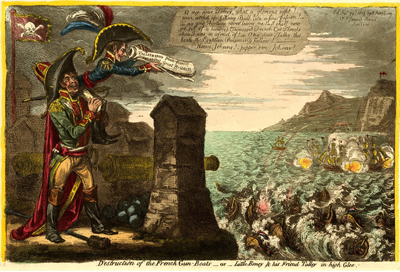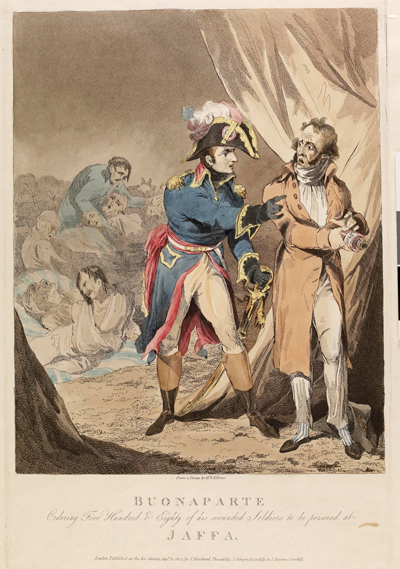Destruction of the French Gun-Boats. . .
In the aftermath of the repudiation of the Treaty of Amiens and the renewal of the war against France in May 1803, Gillray produced a succession of ten or more prints using the various techniques of satiric caricature to downplay the strength of Buonaparte and his army and to heighten and exaggerate the British defenses against invasion.

© Trustees of the British Museum
One of these techniques was to physically diminish Buonaparte by portraying him as short in stature. So in Destruction of the French Gun-Boats, Buonaparte is pictured as so small, when contrasted with his foreign minister Talleyrand, that he has to be lifted like a child upon Talleyrand's shoulder to see over the parapet. Formerly the Bishop of Autun in the Catholic Church, Talleyrand is identified by his bishop's robe and mitre along with his military dress.
Gillray had first created this image of the "Little Boney" even before the collapse of the Amiens Treaty in German Nonchalence, or the Vexation of Little Boney (January 1803). But that was a private print made especially by Gillray for his frequent customer Ludwig, Count Starhemberg, the Austrian Envoy to England, designed to portray Napoleon's pettiness, his "littleness" in responding to some ill-chosen remarks about the First Consul made by Starhemberg while vacationing in Europe.
Gillray's first public portrait of this diminutive version of Buonaparte did not appear until Armed Heroes (May, 18, 1803) published on the very day of the resumption of hostilities with France. But once established, Gillray returned to the technique repeatedly to convince the British public that they had nothing to fear from this manic little opponent. Examples include Maniac Raving's, or Little Boney in a Strong Fit (May 24, 1803), The King of Brobdingnag and Gulliver (June 26, 1803), The Corsican-pest, or Belzebub Going to Supper (October 6, 1803, and this one, Destruction of the French Gun-Boats (November 22, 1803. Gillray was so successful in this effort of reduction that to this day, Napoleon is thought to have been short whereas he was slightly above average for a Frenchman of his time.
Another technique used by Gillray here and in the prints following the resumption of the war was to exaggerate the strength of the potential British resistance to an invasion. In Buonaparte, 48 Hours after Landing (July 26, 1803), he had forecast an easy British victory over Buonaparte in a mere 48 hours. In Death of the Corsican-Fox (July 20, 1803), he suggested that capturing and executing Buonaparte was no more difficult than chasing down a fox in the English countryside. And in Destruction of the French Gun-Boats, he shows the combined British cannon fire from land and sea dispatching French gun-boats as easily as shooting ducks on a pond.
But there is one more way that Gillray attempts to take Buonaparte down a notch—this time by tarnishing his reputation as a general and a human being. As "little Boney" looks through a telescope-like roll of papers labeled "Talleyrand's Plans for invading Great Britain," he exclaims:
O my dear Talley, what a glorious sight! - we've worked up Johnny Bull into a fine passion! - my good fortune never leaves me! - I shall now get rid of a hundred-Thousand French Cut Throats whom I was so afraid of! - O my dear Talley, this beats the Egyptian Poisoning hollow! - Bravo, Johnny! - pepper 'em, Johnny!
The explanation for this rather odd speech from the French General is as follows. As Buonaparte's power as General and First Consul increased, so did plots to kill him. At least one historian estimates that there were between 20 and 30 attempts upon his life during his ascendency in France. By 1803 Buonaparte was becoming increasingly paranoid about the threat of such attacks. Hence his supposed "glee" at being able to get rid of "a hundred-Thousand French Cut Throats whom I was so afraid of!" by sending them against the impregnable defenses of the English. The fact that Buonaparte himself sees the mission as a way of ensuring the removal of these "Cut Throats" is an additional compliment to the British forces.
The "Egyptian Poisoning" in Buonaparte's speech refers to a horrific incident at Jaffa as the wounded and plague-ridden French army retreated back to Cairo. Napoleon is said to have ordered the the camp physician to poison the sickest of his men so that they would not slow the retreat. The incident was widely reported in the British press, and there was a recent print of the incident published just a few months before Gillray's. According to the (exaggerated) account of that print, over 500 sick soldiers were poisoned—a number about to be beaten hollow by the carnage Buonaparte gazes on with glee. No wonder a flag with a death's head flies behind Buonaparte!

[August 12, 1803)
© Trustees of the British Museum
The total effect of Gillray's attack, then, is to portray Buonaparte as a heartless, paranoid, madman, dependent upon Talleyrand, and, incidentally, way too short to be taken seriously.
Sources and Reading
- Commentary from the British Museum on Destruction of the French Gun-Boats. . ..
- "Napoleon," Wikipedia
- "Charles Maurice de Talleyrand-Périgord," Wikipedia
- "Assassination attempts on Napoleon Bonaparte," Wikipedia
- Thomas Wright and R.H. Evans, Historical and Descriptive Account of the Caricatures of James Gillray #282.
- Thomas Wright and Joseph Grego, The Works of James Gillray, the Caricaturist; With the History of His Life and Times, p. 305-6.
Comments & Corrections
NOTE: Comments and/or corrections are always appreciated. To make that easier, I have included a form below that you can use. I promise never to share any of the info provided without your express permission.